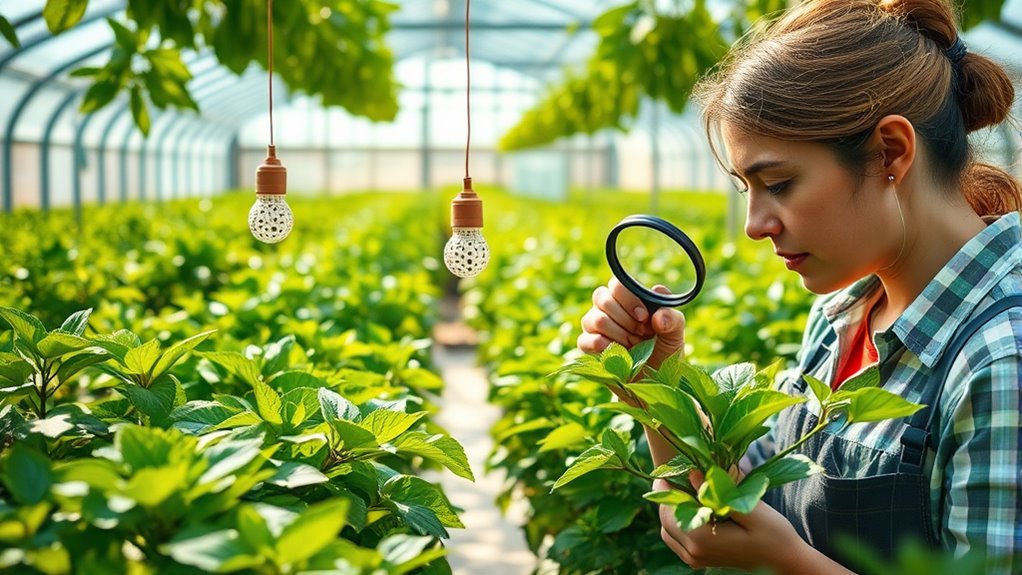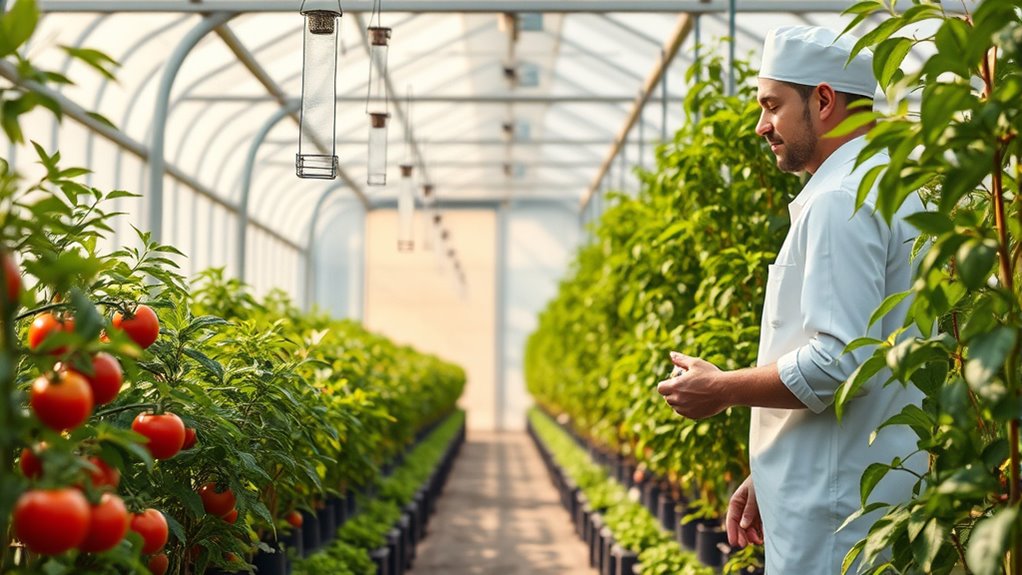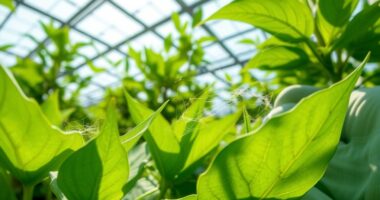Greenhouse IPM is a smart, sustainable way to manage pests by combining biological controls, cultural practices, and careful monitoring. You’ll introduce beneficial insects like ladybugs and use pest traps to catch issues early. Maintaining good sanitation, proper ventilation, and resistant plants helps keep pests in check naturally. This approach minimizes chemical use and promotes a healthy, balanced environment. Keep exploring how these integrated strategies can make pest management easier and more effective for you.
Key Takeaways
- Greenhouse IPM combines biological, cultural, and physical strategies to sustainably manage pests and minimize chemical use.
- Biological controls involve introducing beneficial insects like ladybugs and parasitic wasps to naturally regulate pest populations.
- Regular pest monitoring with traps and inspections helps detect issues early and guides targeted interventions.
- Cultural practices such as sanitation, crop rotation, and proper ventilation enhance plant health and reduce pest habitats.
- Implementing IPM promotes a healthy, resilient ecosystem, reducing chemical dependency and supporting sustainable crop production.

Greenhouse IPM (Integrated Pest Management) offers a sustainable approach to controlling pests while minimizing chemical use. Instead of relying solely on pesticides, you focus on a combination of strategies that work together to keep pests in check. One of the key components is biological controls, which involve introducing natural enemies like beneficial insects or microorganisms that target specific pests. These biological agents help maintain pest populations at manageable levels without harming your plants or the environment. To make this process effective, pest monitoring is essential. Regularly inspecting your plants allows you to identify pest issues early before they become severe. Using sticky traps, visual inspections, and even digital tools, you can track pest populations accurately and determine when intervention is necessary. Pest monitoring helps you avoid unnecessary pesticide applications, reducing chemical dependency and promoting a healthier greenhouse environment. Incorporating innovative pest control solutions like unique planter designs can also contribute to a healthier growing environment by promoting better airflow and drainage, which can help prevent pest infestations. Additionally, pest identification is crucial for selecting the most effective biological agents and tailoring your control strategies to specific pest problems. Proper sanitation and removal of plant debris further support pest management efforts, creating less habitat for pests to thrive in. When implementing biological controls, you should carefully select the right beneficial organisms for your specific pests. For example, releasing ladybugs can control aphids, while parasitic wasps target whiteflies. These natural predators can be introduced proactively or in response to pest outbreaks, but consistent pest monitoring ensures you apply them at ideal times. Maintaining a balanced ecosystem within your greenhouse is essential. Avoid overusing chemical sprays that could wipe out beneficial insects, disrupting your biological control efforts. Instead, integrate biological controls with cultural practices like crop rotation, proper watering, and sanitation, which collectively reduce pest habitats and encourage plant health. Monitoring also involves keeping detailed records of pest trends and biological control effectiveness. This data helps you fine-tune your strategies over time, ensuring you’re using the most effective methods with minimal chemical input. When pests are detected early, you can employ targeted, environmentally friendly controls, preventing populations from reaching damaging levels. This proactive approach not only protects your plants but also enhances the overall sustainability of your greenhouse operation. Remember, biological controls and pest monitoring work best when combined with other practices like physical barriers, resistant plant varieties, and proper ventilation. Moreover, understanding the life cycle of pests can aid in timing interventions more effectively and avoiding unnecessary treatments. In essence, successful greenhouse IPM revolves around vigilant pest monitoring and the strategic use of biological controls. By staying alert to pest activity and leveraging natural enemies, you reduce your reliance on chemicals while maintaining healthy, productive crops. This integrated system fosters a resilient environment where pests are kept in balance naturally, supporting your goal of sustainable and eco-friendly greenhouse management. With consistent effort and careful observation, you’ll find that managing pests becomes a manageable, eco-conscious process that benefits both your plants and the planet.
Frequently Asked Questions
How Does Climate Variability Affect Greenhouse IPM Strategies?
Climate variability influences your greenhouse IPM strategies by requiring climate adaptation and pest outbreak prediction. You need to monitor changing conditions closely, as fluctuations in temperature and humidity can trigger pest outbreaks. Adjust your pest management plans accordingly, using real-time data to predict and respond to pest threats promptly. Staying flexible and informed helps you minimize damage and maintain healthy crops despite unpredictable climate patterns.
What Are the Costs Associated With Implementing Greenhouse IPM?
When you consider the costs of implementing greenhouse IPM, you should conduct a thorough cost analysis and prioritize budget planning. Expenses include monitoring tools, biological controls, and occasional treatments, but these can vary based on your greenhouse size and pest pressure. While initial investments might seem high, effective IPM can reduce long-term pesticide costs, improve crop health, and boost yields, making it a worthwhile, strategic choice for sustainable pest management.
How Can Small-Scale Growers Adopt IPM Effectively?
To adopt IPM effectively as a small-scale grower, you should focus on crop diversification to reduce pest buildup and implement biological monitoring to detect issues early. These strategies help minimize chemical use and promote sustainable practices. Start small, observe pest patterns regularly, and adjust your methods accordingly. By integrating these practices, you can manage pests efficiently, save costs, and improve crop health over time.
Are There Any Legal Restrictions on Using Biocontrol Agents?
You should be aware that biocontrol regulations vary by region, so it’s essential to check local laws to make certain legal compliance. Some areas restrict certain biocontrol agents due to environmental or safety concerns. Before using them, review applicable regulations and obtain necessary permits if required. Staying informed about legal restrictions helps you use biocontrol agents responsibly and effectively, avoiding potential fines or legal issues.
How to Measure the Success of an Integrated Pest Management Program?
Oh, measuring success is so overrated—yet here you are. You can monitor your pests with simple techniques, like sticky traps or visual inspections, to track pest populations. The real trick is setting a pest threshold—knowing when pest levels become problematic. When your monitoring shows pest numbers stay below that threshold, you’ve succeeded in your IPM efforts. It’s all about consistent vigilance and smart decision-making.
Conclusion
Now that you understand greenhouse IPM, you’re armed with simple strategies to protect your plants. Think of it like balancing a delicate dance—while pests are the unwanted guests, your proactive management keeps everything in harmony. Just as a gardener tends patiently, your consistent efforts ensure healthy crops and a thriving greenhouse. With IPM, you turn complexity into clarity, creating a lush, resilient space where pests don’t stand a chance and your plants flourish effortlessly.









